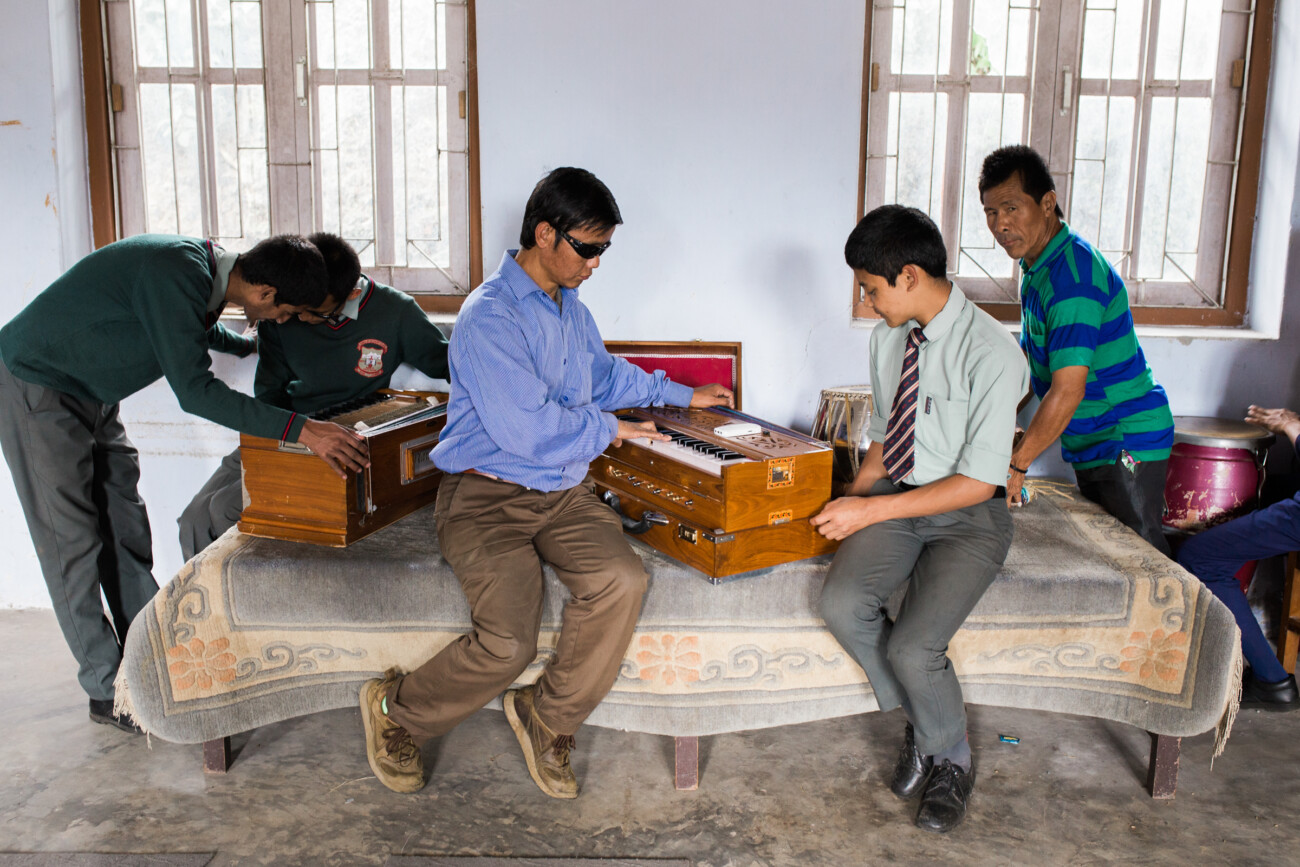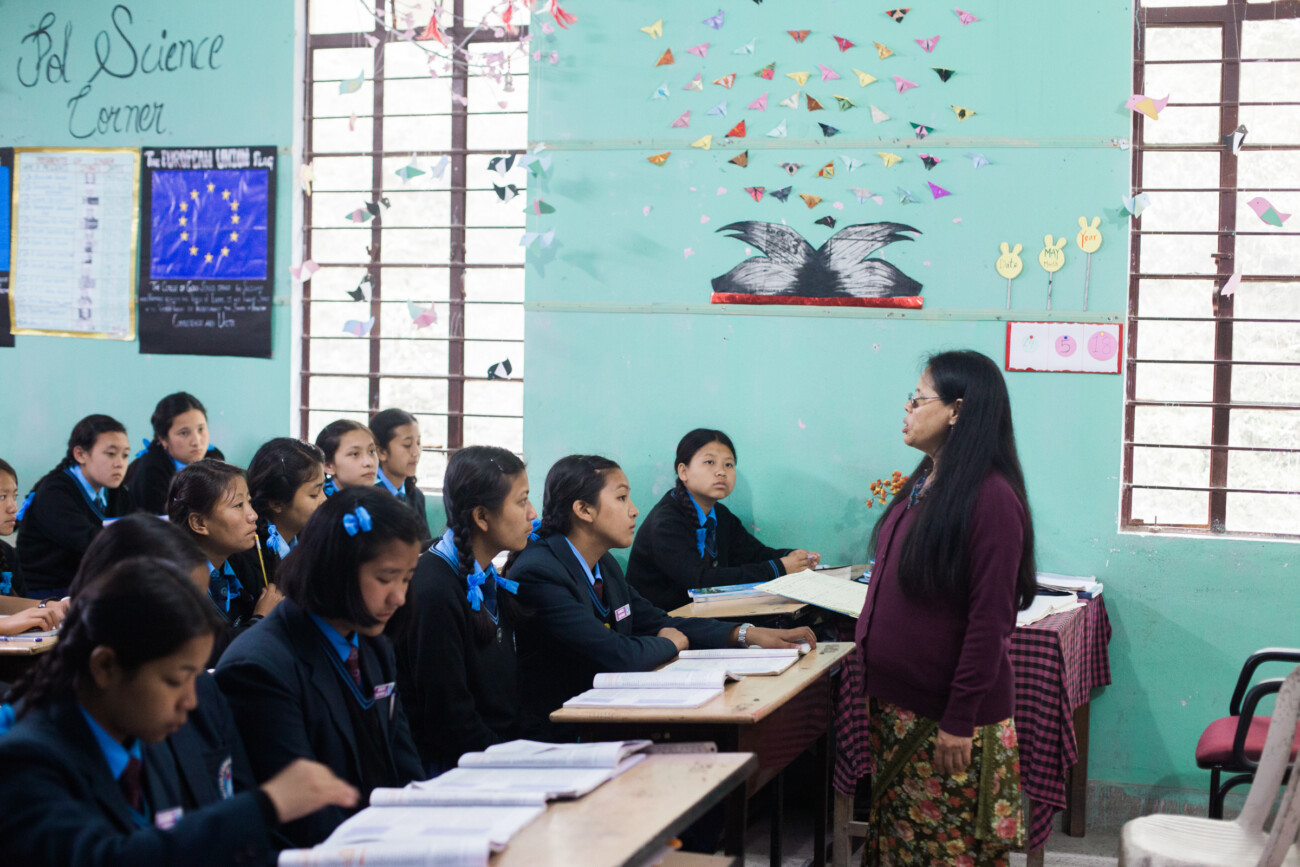The Jawaharlal Nehru Memorial Institute for Handicapped, located in Boomtar, Namchi, is the only school for the blind in Sikkim. Its foundation stone was laid on 14 November, 1987, by Shri Nar Bahadur Bhandari, the then Chief Minister of Sikkim. The school was established at the initiative of the National Association for the Blind (NAB), and later, taken over by the government.
The school has a large area with gardens, play grounds, dormitories and classrooms built to suit the visually impaired students. On 13 July, 2016, the Garden of Senses was opened in the school, supported by State Bank of India and NAB. Parents from all over Sikkim bring their children to the school; and some come from as far away as Siliguri in North Bengal. In 2017 there were thirty-one students and nine teachers; classes continue up to class five. This favourable student-teacher ratio ensures close attention to learning. Apart from learning to read and write in braille, the students participate in activities, such as, music, computer literacy and sports. In 2012, three children were sent to participate in the Chennai Sports Meet, and all three won medals. Earlier, in 2008, ten students went on a training course at the Himalayan Mountaineering Institute, Darjeeling. Chess and cricket are also popular games at the school.

Jiwan Rai joined as the first Principal of Jawaharlal Nehru Memorial Institute for Handicapped in 1988. Initially, he studied at the Blind School in Kalimpong and completed his school from the Scottish University Mission India (SUMI) in the same town. In 1981, he underwent training in Kolkata before he joined the school.
Devimaya Chettri has been teaching in the school since 1989 and has undergone a special training to teach blind students in Dehradun and Delhi. However, Devimaya Chettri observes the change of attitude in students, “Earlier, students were more enthusiastic, and asked many questions. Now, they appear to be less interested. We are unable to understand this change”.
After passing class five, the students go on to complete their schooling at the two government Senior Secondary Schools in Namchi, for boys and girls respectively. The process of integrating them into the normal school system further helps them to gain self-confidence. However, the initial stage of moving from a sheltered school to a regular one does have its own set of problems. Coping with the sheer number of students in the class, averaging about fifty students, overwhelms them in the beginning, and they feel excluded from the larger school body. Over the years, conscious efforts have been made by the teachers to inculcate sensitivity in other students. For instance, class teachers are especially asked to seat them with other students. This has had a very positive effect in bonding; such is the case with Hemant and Santosh who are best friends and help each other. A teacher remarked that earlier the blind students would stay close together, but now they mingle with others more readily.

Students now take DAISY (Digital Accessible Information System) recorders to class to record lessons. Although there are an increasing number of text books in braille, but not all the textbooks are available. In 2017 the school was given a braille printer which has proved to be of great help in preparing lessons for the students. The Senior Boys’ school has appointed a special person, Norbu Lepcha, an alumnus of the Jawaharlal Nehru Memorial Institute for Handicapped and the Boys Senior Secondary School, Namchi, to deal with the specific problems that the blind students face. He assists when help is needed, such as in reading examination answer papers for the teachers.
Speaking about the students, teachers remarked that the visually impaired students are generally more focused and are not easily distracted like other students. They perform well in class. Many of those who have graduated from these schools have gone on to study in colleges and have taken up posts either as teachers, or in government departments, or as physiotherapists in the local hospital. As a result, the impression that visually impaired persons are less abled has changed over time. One student from Girls Senior Secondary School has joined the prestigious Jawaharlal Nehru University in New Delhi.


However, the struggle to be accepted and overcome prejudice is not over yet. Once, when Uma Mukhia, a blind senior school teacher of history was called to the principal’s office on some work, the boys in her class began making a lot of noise and when another teacher came to investigate, and asked, “Whose class is this?” Prompt came the answer from the students, “Blind teacher.” Norbu Lepcha, who was in the same class, got up furious and asked, “Don’t blind people have names?” The teacher had a hard time restraining him. This reaction of Norbu must have sprung from a deep awareness of the discrimination that persons with disabilities have to face on a daily basis.
Uma says how, on any given day, they are looked down upon because they are blind. She recounts that one day a man who wasn’t looking where he was walking tripped on her walking cane. In a rage, he snatched the stick from her hand and twisted it, trying to break it. The only people who seemed to be sympathetic are the drug addicts, drunks and beggars who volunteer to guide them across difficult crossings. A painful incident happened to another blind man who works in the hospital as a physiotherapist. He used to walk to his workplace with the help of a cane. One day he was caught in a traffic snarl and he slipped and fell into a gutter. Instead of helping him, people laughed saying that the blind doctor has fallen. Ever since that day he has stopped walking to work and always uses a car.
Uma Mukhia: A profile in courage

When Uma was four-years-old, she lost her eyesight from measles. From a bright world that she inhabited, she entered a world of darkness in bewilderment and pain. Soon after, her father took her to the Mary Scott School for the Blind in Kalimpong. She was the youngest child at the school. Later Uma was told by her hostel matron that she wept for a whole month. The kind matron would make her sleep beside her and comfort her by saying that she was her aunt. Soon after, another four-year-old girl joined the school and from then on Uma began to settle down, having found a friend her age.
Uma was a bright child and always ahead of other students in her class. After completing her primary and elementary school in Mary Scott School, she joined the Girls School where she completed her class twelve with merit. Then the important decision regarding further studies had to be taken. She joined Wilson College in Mumbai in 1989, where she enrolled for a B.A. degree. She was interested in the sciences but because of her blindness that avenue of studies was closed. After her B.A. she enrolled for her M.A. in History at the Bombay University. She says that her interest in history grew when she studied the freedom movement in school.
In 2000 and 2001, Uma undertook a computer training as well as a teacher’s training at the Blind Relief Association in Delhi. One of the major problems the blind people face is the lack of braille books in terms of variety as well as quantity.
Her sister, Shanti, accompanied her on the first trip to Mumbai and helped with the admission process and settling her in. Thereafter, Uma managed on her own. Reflecting on her long train journeys to and from Mumbai, which she made on her own, she wonders how she managed it all. At the New Jalpaiguri station, Shanti would help her to board the train and friends would meet her in Mumbai. “Those days, I was not afraid. I felt I could do anything,” she says.
In 1995, she was appointed in-charge of the Jawaharlal Nehru Memorial Institute for Handicapped in Namchi, and the same year she was made the principal of the school. There was an opening for a lecturer’s post in the Namchi Government College that year and she applied. Her file was held up and the bureaucratic notations that were found later indicated a bias against her blindness. One comment read, ‘How can a blind teach normal students?’

In 2003, a workshop was held under the aegis of Rehabilitation Council of India (RCI) in collaboration with the NAB, Sikkim branch, to explore the possibilities of appointing qualified differently-abled people to fill positions in the government. Mrs Jayashri Pradhan was the Secretary of the Department of Human Resource Development, and it was she who saw the jottings on Uma’s file. There was an urgency in finding a suitable candidate to fill a vacancy, so Uma was chosen for a post of a senior teacher for Boys Senior Secondary School. She joined the school in September, 2003, and thereafter in 2007 she joined her current position in the Girls Senior Secondary School. When asked the difference between teaching girls and boys, she says that boys tend to be more mischievous, and the girls are quieter.
Uma finds that the girls’ willingness to confide in her allows her to also help them resolve emotional problems. Adolescence can be painful and confusing. Years later when she meets the girls whom she had counselled, they unfailingly acknowledge her sound advice and support during their formative years. She reveals that she has even counselled girls who were thinking of committing suicides.
She finds that it is easier for visually impaired persons to move around in the metropolitan cities, to find willing readers, as well as braille books.
In 2000 and 2001, Uma undertook a computer training as well as a teacher’s training at the Blind Relief Association in Delhi. One of the major problems the blind people face is the lack of braille books in terms of variety as well as quantity. For instance, while there are some essential text books in English, there are no books in the Nepali language for older students. In comparison, there are many Bengali books in braille, promoted mainly by the Rama Krishna Mission. There are a few audio books, but one of their drawbacks is that the students do not learn to spell.
Remembering her schooling, Uma reiterates that it was an uphill task to study without adequate books, and finding readers and scribes was also difficult in the hills. She finds that it is easier for visually impaired persons to move around in the metropolitan cities, to find willing readers, as well as braille books.
All through her life Uma has triumphed because of her grit and perseverance. The latest award she received is the ‘Nation Builder’ for 2018 by the Rotary Club, South Sikkim.
Uma is happily married and has a son who is growing up under her guidance and love, and to whom she imparts the same values that she gives to her students.
3 comments on “LIVING AND LEARNING IN THE ONLY SCHOOL FOR THE BLIND IN SIKKIM”
Leave a Reply
Latest Posts
Latest Comments
No 'Comments_Widget_Plus_Widget' widget registered in this installation.


So touching and motivating.
Kudos to the teachers and taught.
It's shocking how so called normal people are so blind. Their lack of empathy and downright callousness is unbelievable.
A tired word, 'inspiring' but no other will do for this piece. Im so glad such a school and teachers (and students!) exists, but sorry that the impulse to mock handicaps persists. There is a feature film of a Tibetan school for the blind, (not sure where located) whose students learn mountain climbing, even so, are mocked; their 'past lives' blamed for their lost vision. Could primary school teachers in Sikkim flag this attitude as something needing attention? Work to redress?